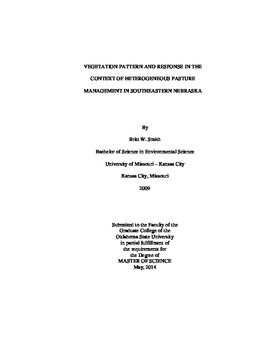| dc.contributor.advisor | Fuhlendorf, Samuel D. | |
| dc.contributor.author | Smith, Britt W. | |
| dc.date.accessioned | 2015-06-17T20:08:06Z | |
| dc.date.available | 2015-06-17T20:08:06Z | |
| dc.date.issued | 2014-05-01 | |
| dc.identifier.uri | https://hdl.handle.net/11244/15129 | |
| dc.description.abstract | Prior to European settlement, the interaction of fire and grazing was a dominant disturbance and driver of vegetation structure and diversity in the Great Plains. Periodic wildfires and anthropogenic fires created burned areas on which grazing animals would congregate and consume highly palatable forage regrowth. In recent years, rangeland management practices have sought to reintroduce this interaction into confined pasture settings. Several studies have shown benefits for native plants and wildlife. Most of such studies have been conducted on conservation lands and experimental research stations. This study was conducted on both public conservation land and private working rangeland in southeastern Nebraska. Depending on the scale and functional level examined, vegetation can either be influenced by or can have potential confounding influences on rangelands managed with fire and grazing.At the pasture level, vegetation structure was found to be more heterogeneous in pastures managed with patch burning compared to pastures managed in a more traditional manner. Significant differences between measures of plant diversity between treatments were not observed. Plant community composition was found to vary across the landscape due largely to ownership and regional edaphic characteristics. Examining specific butterfly host plant species, no significant differences were observed between treatmentsnor between differences in time since fire. At the landscape scale, woodland vegetation was found to have an influence on the abundance of grassland birds and a potentially confounding influence on heterogeneous pasture management.Incorporating fire and grazing onto private working rangelands can create vegetation heterogeneity, which has shown benefits for wildlife. Plant genera that have evolved with fire and grazing in the Great Plains should be adapted to, and potentially benefit from this management. Further, depending on vegetation that exists in the greater landscape, such as woodland vegetation, goals and objectives can be confounded. | |
| dc.format | application/pdf | |
| dc.language | en_US | |
| dc.publisher | Oklahoma State University | |
| dc.rights | Copyright is held by the author who has granted the Oklahoma State University Library the non-exclusive right to share this material in its institutional repository. Contact Digital Library Services at lib-dls@okstate.edu or 405-744-9161 for the permission policy on the use, reproduction or distribution of this material. | |
| dc.title | Vegetation Pattern and Response in the Context of Heterogeneous Pasture Management in Southeastern Nebraska | |
| dc.type | text | |
| dc.contributor.committeeMember | Engle, David M. | |
| dc.contributor.committeeMember | Baum, Kristen | |
| osu.filename | Smith_okstate_0664M_13402.pdf | |
| osu.accesstype | Open Access | |
| dc.description.department | Natural Resources and Ecology Management | |
| dc.type.genre | Thesis | |
| dc.subject.keywords | fire | |
| dc.subject.keywords | grazing | |
| dc.subject.keywords | nebraska | |
| dc.subject.keywords | patch burn | |
| dc.subject.keywords | pyric-herbivory | |
| dc.subject.keywords | rangeland | |
